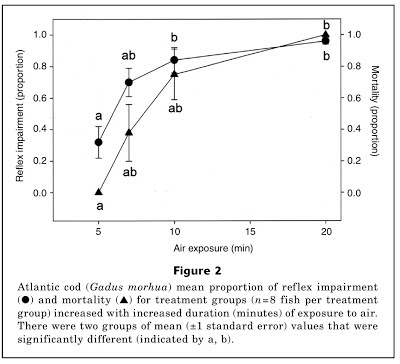Fishing is conducted in freshwater and seawater, with catch retained, discarded, released, or escaped from commercial, recreational, catch and release, and subsistence fisheries. In all cases, knowledge of target and non-target fishing mortality is essential for management and conservation of fisheries stocks and ecosystems. Fishing occurs under a variety of environmental and operational conditions. Examples of fishing gears include trawls, seines, traps, dredges, hook and line, gill nets, lift nets, and falling gear. While immediate mortality is evident for non-target bycatch discards, delayed mortality is generally hidden from view for discards and escapees from fishing gears and operations.
Fishing factors include a range of types for discards and escapees. Master controlling variables include temperature, air exposure, gear injury, fatigue and exhaustion, fish size, barotrauma, and predators. Synergistic effects of combinations of factors can be significant controllers of mortality.
Davis 2002 capture and discard
Suuronen 2005 capture and escape
Bycatch mortality can be modeled by experimental determination of relationships among environmental and operational factors and mortality rates of various species, either under laboratory or field conditions. Since there are an almost infinite number of factor combinations in a fishery, it is important to prioritize the stress and mortality effects of factors and factor combinations. Primary effects are then modeled for mortality rates.
Effects of fish size, fishing gear type, and temperature on sablefish mortality, AFSC
A second approach to modeling bycatch mortality is to shift focus from environmental and operational fishing conditions to a more limited set of predictors for mortality based on animal condition. These include wounding, physiological impairment, and reflex impairment. Reflex impairment and RAMP have been found to be the most efficient and inclusive predictors of immediate and delayed mortality.
RAMP curves for the relationships between reflex impairment and species mortality are constructed under simulated or actual fishing conditions that are expected.
Using constructed RAMP curves, bycatch mortality rates can be measured and predicted in fishing operations through time and space by sampling fish from fisheries.
Hybrid combinations of the two modeling approaches can be used if data are available. Animals that are captured or escape from fishing gears can be sampled for RAMP while environmental and operational conditions are noted. Then relationships among these factors can be modeled.
Effect of air exposure on Atlantic cod reflex impairment and mortality, Humborstad et al. 2009








No comments:
Post a Comment
Note: Only a member of this blog may post a comment.